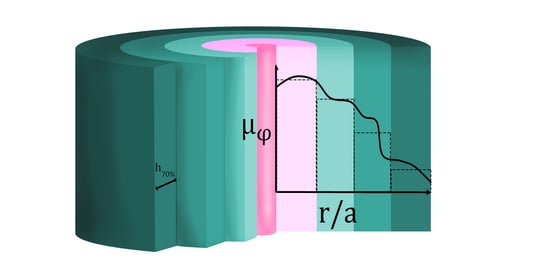An Indirect Method of Micromagnetic Structure Estimation in Microwires
Abstract
1. Introduction
2. Materials and Methods
2.1. Materials
2.1.1. Amorphous Magnetic Microwires
2.1.2. Investigated Samples of Amorphous Magnetic Microwires
2.2. Methods
2.2.1. Impedance of the Wires and Permeability Calculation
Theoretical Background
- (i)
- using the experimental data on the wire impedance, the real and imaginary parts of permeability were determined from Equations (1) and (2);
- (ii)
- knowing the permeability value, the corresponding current penetration depth at every frequency was obtained from Equation (3);
- (iii)
- for each subsequent pair of permeability and penetration depth values the average permeability for the differential layer (red layer in Figure 3) was obtained. The values obtained were presented in the form of a histogram, where the pillar height and width represent the local permeability and the thickness of the differential layer, respectively.
2.2.2. Magnetostatic Measurements
2.2.3. Experimental Equipment
3. Results and Discussion
3.1. Conventional Hysteresis Loops
3.2. Field Dependence of the Cross-Magnetic Moment
3.3. Remanent Magnetization State Analysis
3.4. Magnetoimpedance
3.5. Radial Distribution of Magnetic Permeability
4. Conclusions
Supplementary Materials
Author Contributions
Funding
Informed Consent Statement
Data Availability Statement
Conflicts of Interest
References
- Coey, J.M.D. Amo rphous magnetic order. J. Appl. Phys. 1978, 49, 1646–1652. [Google Scholar] [CrossRef]
- Alam, J.; Bran, C.; Chiriac, H.; Lupu, N.; Óvári, T.A.; Panina, L.V.; Rodionova, V.; Varga, R.; Vázquez, M.; Zhukov, A. Cylindrical micro and nanowires: Fabrication, properties and applications. J. Magn. Magn. Mater. 2020, 513, 167074. [Google Scholar] [CrossRef]
- Zhukova, V.; Ipatov, M.; Zhukov, A. Thin Magnetically Soft Wires for Magnetic Microsensors. Sensors 2009, 9, 9216–9240. [Google Scholar] [CrossRef] [PubMed]
- Zhukov, A.; Ipatov, M.; Churyukanova, M.; Talaat, A.; Blanco, J.M.; Zhukova, V. Trends in optimization of giant magnetoimpedance effect in amorphous and nanocrystalline materials. J. Alloy. Compd. 2017, 727, 887–901. [Google Scholar] [CrossRef]
- Rodionova, V.; Ilyn, M.; Ipatov, M.; Zhukova, V.; Perov, N.; Zhukov, A. Spectral properties of electromotive force induced by periodic magnetization reversal of arrays of coupled magnetic glass-covered microwires. J. Appl. Phys. 2012, 111, 07E735. [Google Scholar] [CrossRef]
- Hayashi, M.; Thomas, L.; Moriya, R.; Rettner, C.; Parkin, S.S.P. Current-Controlled Magnetic Domain-Wall Nanowire Shift Register. Science 2008, 320, 209–211. [Google Scholar] [CrossRef]
- Kuzminski, M.; Nesteruk, K.; Lachowicz, H.K. Magnetic field meter based on giant magnetoimpedance effect. Sens. Actuat. A Phys. 2008, 141, 68–75. [Google Scholar] [CrossRef]
- Li, D.R.; Lu, Z.C.; Zhou, S.X. Magnetic anisotropy and stress-impedance effect in Joule heated Fe73.5Cu1Nb3Si13.5B9 ribbons. J. Appl. Phys. 2004, 95, 204207. [Google Scholar] [CrossRef]
- Zhukov, A. Domain wall propagation in a Fe-rich glass-coated amorphous microwire. Appl. Phys. Lett. 2001, 78, 3106–3108. [Google Scholar] [CrossRef]
- Vázquez, M.; Chiriac, H.; Zhukov, A.; Panina, L.; Uchiyama, T. On the state-of-the-art in magnetic microwires and expected trends for scientific and technological studies. Phys. Status Solidi A 2010, 207, 1. [Google Scholar] [CrossRef]
- Panina, L.V.; Mohri, K. Magnetoimpedance effect in amorphous wires. Appl. Phys. Lett. 1994, 65, 11891191. [Google Scholar] [CrossRef]
- Sartorelli, M.L.; Knobel, M.; Schoenmaker, J.; Gutierrez, J.; Barandiaran, J.M. Giant magneto-impedance and its relaxation in CoFeSiB amorphous ribbons. Appl. Phys. Lett. 1997, 71, 22082210. [Google Scholar] [CrossRef]
- Zhukov, A.; González, J.; Vázquez, M.; Larin, V.; Torcunov, A. Nanocrystalline and Amorphous Magnetic Microwires. In Encyclopedia of Nanoscience and Nanotechnology; Nalwa, H.S., Ed.; American Scientific: Stevenson Ranch, CA, USA, 2014; Volume 6, pp. 365–367. [Google Scholar]
- Rodionova, V.; Baraban, I.; Chichay, K.; Litvinova, A.; Perov, N. The stress components effect on the Fe-based microwires magnetostatic and magnetostrictive properties. J. Magn. Magn. Mater. 2017, 422, 216–220. [Google Scholar] [CrossRef]
- Zhukova, V.; Blanco, J.M.; Corte-Leon, P.; Ipatov, M.; Churyukanova, M.; Taskaev, S.; Zhukov, A. Grading the magnetic anisotropy and engineering the domain wall dynamics in Fe-rich microwires by stress-annealing. Acta Mater. 2018, 155, 279–285. [Google Scholar] [CrossRef]
- Zhukova, V.; Umnov, P.; Molokanov, V.; Shalygin, A.N.; Zhukov, A.P. Studies of Magnetic Properties of Amorphous Microwires Produced by Combination of by Quenching, Glass Removal and Drawing Techniques. Key Eng. Mater. 2011, 495, 280–284. [Google Scholar] [CrossRef]
- Baraban, I.; Panina, L.; Litvinova, A.; Rodionova, V. Effect of glass-removal on the magnetostriction and magnetic switching properties in amorphous FeSiB microwires. J. Magn. Magn. Mater. 2019, 481, 50–54. [Google Scholar] [CrossRef]
- Panina, L.V.; Dzhumazoda, A.; Evstigneeva, S.A.; Adam, A.M.; Morchenko, A.T.; Yudanov, N.A.; Kostishyn, V.G. Temperature effects on magnetization processes and magnetoimpedance in low magnetostrictive amorphous microwires. J. Magn. Magn. Mater. 2018, 459, 147–153. [Google Scholar] [CrossRef]
- Chiriac, H.; Óvári, T.A.; Pop, G.; Barariu, F. Magnetic behavior of nanostructured glass covered metallic wires. J. Appl. Phys. 1997, 81, 5817. [Google Scholar] [CrossRef]
- Azuma, D.; Hasegawa, R.; Saito, S.; Takahashi, M. Effect of residual strain in Fe-based amorphous alloys on field induced magnetic anisotropy and domain structure. J. Appl. Phys. 2013, 113, 17A339. [Google Scholar] [CrossRef]
- Hasegawa, R.; Takahashi, K.; Francoeur, B.; Couture, P. Magnetization kinetics in tension and field annealed Fe-based amorphous alloys. J. Appl. Phys. 2013, 113, 17A312. [Google Scholar] [CrossRef]
- Usov, N.A.; Antonov, A.S.; Lagar’kov, A.N.; Granovsky, A.B. GMI spectra of amorphous wires with different types of magnetic anisotropy in the core and the shell regions. J. Magn. Magn. Mater. 1999, 203, 108–110. [Google Scholar] [CrossRef]
- Donnely, C.; Guizar-Sicairos, M.; Scagnoli, V.; Gliga, S.; Holler, M.; Raabe, J.; Heyderman, L.J. Three-dimensional magnetization structures revealed with X-ray vector nanotomography. Nature 2017, 547, 328–331. [Google Scholar] [CrossRef]
- Chizhik, A.; Zhukov, A.; González, J.; Gawroński, P.; Kułakowski, K. Spiral magnetic domain structure in cylindrically-shaped microwires. Sci. Rep. 2018, 8, 15090. [Google Scholar] [CrossRef]
- González, J.; Chizhik, A.; Zhukov, A.; Blanco, J.M. Surface magnetization reversal and magnetic domain structure in amorphous microwires. Phys. Status Solidi A 2011, 208, 502–508. [Google Scholar] [CrossRef]
- Zhukov, A.; Blanco, J.M.; Chizik, A.; Ipatov, M.; Rodionova, V.; Zhukova, V. Manipulation of domain wall dynamics in amorphous microwires through domain wall collision. J. Appl. Phys. 2013, 114, 043910. [Google Scholar] [CrossRef]
- Zhukov, A.P.; Vázquez, M.; Velazquez, J.; Chiriac, H.; Larin, V. The remagnetization process in thin and ultra-thin Fe-rich amorphous wires. J. Magn. Magn. Mater. 1995, 151, 132–138. [Google Scholar] [CrossRef]
- Rodionova, V.; Ipatov, M.; Ilyn, M.; Zhukova, V.; Perov, N.; González, J.; Zhukov, A. Tailoring of Magnetic Properties of Magnetostatically-Coupled Glass-Covered Magnetic Microwires. J. Supercond. Nov. Magn. 2011, 24, 541–547. [Google Scholar] [CrossRef]
- Makhnovskiy, D.P.; Panina, L.V.; Mapps, D.J. Field-dependent surface impedance tensor in amorphous wires with two types of magnetic anisotropy: Helical and circumferential. Phys. Rev. B 2001, 63, 144424. [Google Scholar] [CrossRef]
- Zhukov, A.; Zhukova, V.; Blanco, J.M.; Cobeño, A.F.; Vázquez, M.; González, J. Magnetostriction in glass-coated magnetic microwires. J. Magn. Magn. Mater. 2003, 258, 151–157. [Google Scholar] [CrossRef]
- Ekstrom, P.A.; Zhukov, A. Spatial structure of the head-to-head propagating domain wall in glass-covered FeSiB microwire. J. Phys. D Appl. Phys. 2010, 43, 205001. [Google Scholar] [CrossRef]
- Chiriac, H.; Óvári, T.A.; Pop, G. Internal stress distribution in glass-covered amorphous magnetic wires. Phys. Rev. B 1995, 52, 10104–10113. [Google Scholar] [CrossRef] [PubMed]
- Antonov, A.S.; Borisov, V.T.; Borisov, O.V.; Prokoshin, A.F.; Usov, N.A. Residual quenching stresses in glass-coated amorphous ferromagnetic microwires. J. Phys. D Appl. Phys. 2000, 33, 1161–1168. [Google Scholar] [CrossRef]
- Chizhik, A.; Garcia, C.; Zhukov, A.; Gawroński, P.; Kułakowski, K.; González, J.; Blanco, J.M. Investigation of helical magnetic structure in Co-rich amorphous microwires. J. Magn. Magn. Mater. 2007, 316, 332–336. [Google Scholar] [CrossRef]
- Chizhik, A.; Blanco, J.M.; Zhukov, A.; González, J.; Garcia, C.; Gawroński, P.; Kulakowski, K. Magneto-optical determination of helical magnetic structure in amorphous microwires. Phys. B Condens. Matter 2008, 403, 289–292. [Google Scholar] [CrossRef]
- Severino, A.M.; Gómez-Polo, C.; Marín, P.; Vázquez, M. Influence of the sample length on the switching process of magnetostrictive amorphous wire. J. Magn. Magn. Mater. 1992, 103, 117–125. [Google Scholar] [CrossRef]
- Liu, K.; Lu, Z.; Liu, T.; Li, D. Measurement of internal tensile stress in Co68.2Fe4.3Cr3.5Si13B11 glass-coated amorphous microwires using the stress sensitivity of saturation magnetostriction. J. Magn. Magn. Mater. 2013, 339, 124–126. [Google Scholar] [CrossRef]
- Panina, L.; Dzhumazoda, A.; Nematov, M.; Alam, J.; Trukhanov, A.; Yudanov, N.; Morchenko, A.; Rodionova, V.; Zhukov, A. Soft Magnetic Amorphous Microwires for Stress and Temperature Sensory Applications. Sensors 2019, 19, 5089. [Google Scholar] [CrossRef] [PubMed]
- Vázquez, M. Advanced Magnetic Microwires. In Handbook of Magnetism and Advanced Magnetic Materials; Kronmüller, H., Parkin, S., Eds.; Wiley: Chichester, UK, 2007; Volume 4, pp. 2193–2296. [Google Scholar]
- Larin, V.S.; Torcunov, A.V.; Zhukov, A.; González, J.; Vázquez, M.; Panina, L. Preparation and properties of glass-coated microwires. J. Magn. Magn. Mater. 2002, 249, 39–45. [Google Scholar] [CrossRef]
- Rodionova, V.V.; Baraban, I.A.; Panina, L.V.; Bazlov, A.I.; Perov, N.S. Tunable magnetic properties of glass-coated microwires by initial technical parameters. IEEE Trans. Magn. 2018, 54, 2002706. [Google Scholar] [CrossRef]
- Buznikov, N.A.; Antonov, A.S.; Granovsky, A.B. Asymmetric magnetoimpedance in amorphous microwires due to bias current: Effect of torsional stress. J. Magn. Magn. Mater. 2014, 355, 289–294. [Google Scholar] [CrossRef]
- Chizhik, A.; Garcia, C.; Zhukov, A.; González, J.; Gawroński, P.; Kułakowski, K.; Blanco, J.M. Relation between surface magnetization reversal and magnetoimpedance in Co-rich amorphous microwires. J. Appl. Phys. 2008, 103, 1–4. [Google Scholar] [CrossRef]
- Sossmeier, K.D.; Oliveira, J.T.D.; Schelp, L.F.; Carara, M. Domain wall dynamics in CoFeSiB microwires under axial applied stress. J. Magn. Magn. Mater. 2007, 316, e541–e544. [Google Scholar] [CrossRef]
- Dionne, G.F. Magnetic relaxation and anisotropy effects on high-frequency permeability. IEEE Trans. Magn. 2003, 39, 3121–3126. [Google Scholar] [CrossRef]
- Astefanoaei, I.; Radu, D.; Chiriac, H. Internal stress distribution in DC joule-heated amorphous glass-covered microwires. J. Phys. Cond. Matter. 2006, 18, 2689–2716. [Google Scholar] [CrossRef]
- Torrejon, J.; Thiaville, A.; Adenot-Engelvin, A.L.; Vázquez, M.; Acher, O. Cylindrical magnetization model for glass-coated microwires with circular anisotropy: Statics. J. Magn. Magn. Mater. 2011, 323, 283–289. [Google Scholar] [CrossRef]
- Perov, N.; Radkovskaya, A.A. Vibrating sample anisometer. In Proceeding of 1&2 Dimensional Magnetic Measurements and Testing; Vienna Magnetic Group Report: Vienna, Austria, 2001; pp. 104–108. [Google Scholar]
- Vázquez, M.; Zhukov, A.P.; Garcıa, K.L.; Pirota, K.R.; Ruiz, A.; Martinez, J.L.; Knobel, M. Temperature dependence of magnetization reversal in magnetostrictive glass-coated amorphous microwires. Mat. Sci. Eng. A 2004, 375–377, 1145–1148. [Google Scholar]
- Barandiaran, J.M.; Hernando, A.; Madurga, V.; Nielsen, O.V.; Vázquez, M.; Vázquez-Lopez, M. Temperature, stress, and structural-relaxation dependence of the magnetostriction in (Co0.94/BFe0.06)75/BSi15B10 glasses. Phys. Rev. B 1987, 35, 5066. [Google Scholar] [CrossRef] [PubMed]
- Churyukanova, M.; Semenkova, V.; Kaloshkin, S.; Shuvaeva, E.; Gudoshnikov, S.; Zhukova, V.; Shchetinin, I.; Zhukov, A. Magnetostriction investigation of soft magnetic microwires. Phys. Status Solidi A 2016, 213, 363–367. [Google Scholar] [CrossRef]
- Chichay, K.; Rodionova, V.; Zhukova, V.; Kaloshkin, S.; Churyuknova, M.; Zhukov, A. Investigation of the magnetostriction coefficient of amorphous ferromagnetic glass coated microwires. J. Appl. Phys. 2014, 116, 173904. [Google Scholar] [CrossRef]
- Nematov, M.G.; Baraban, I.; Yudanov, N.A.; Rodionova, V.; Qin, F.X.; Peng, H.-X.; Panina, L.V. Evolution of the magnetic anisotropy and magnetostriction in Co-based amorphous alloys microwires due to current annealing and stress-sensory applications. J. Alloy. Comp. 2020, 837, 155584. [Google Scholar] [CrossRef]
- Liu, K.; Lu, Z.; Liu, T.; Li, D. Influence of Tensile Force During Preparation on Internal Stress of Glass-Coated Microwires. J. Supercond. Nov. Magn. 2013, 26, 2969–2973. [Google Scholar] [CrossRef]
- Zhukov, A.; Chichay, K.; Talaat, A.; Rodionova, V.; Blanco, J.M.; Ipatov, M.; Zhukova, V. Manipulation of magnetic properties of glass-coated microwires by annealing. J. Magn. Magn. Mater. 2015, 383, 232–236. [Google Scholar] [CrossRef]
- Vázquez, M. Giant magneto-impedance in soft magnetic “Wires”. J. Magn. Magn. Mater. 2001, 226–230, 693–699. [Google Scholar]

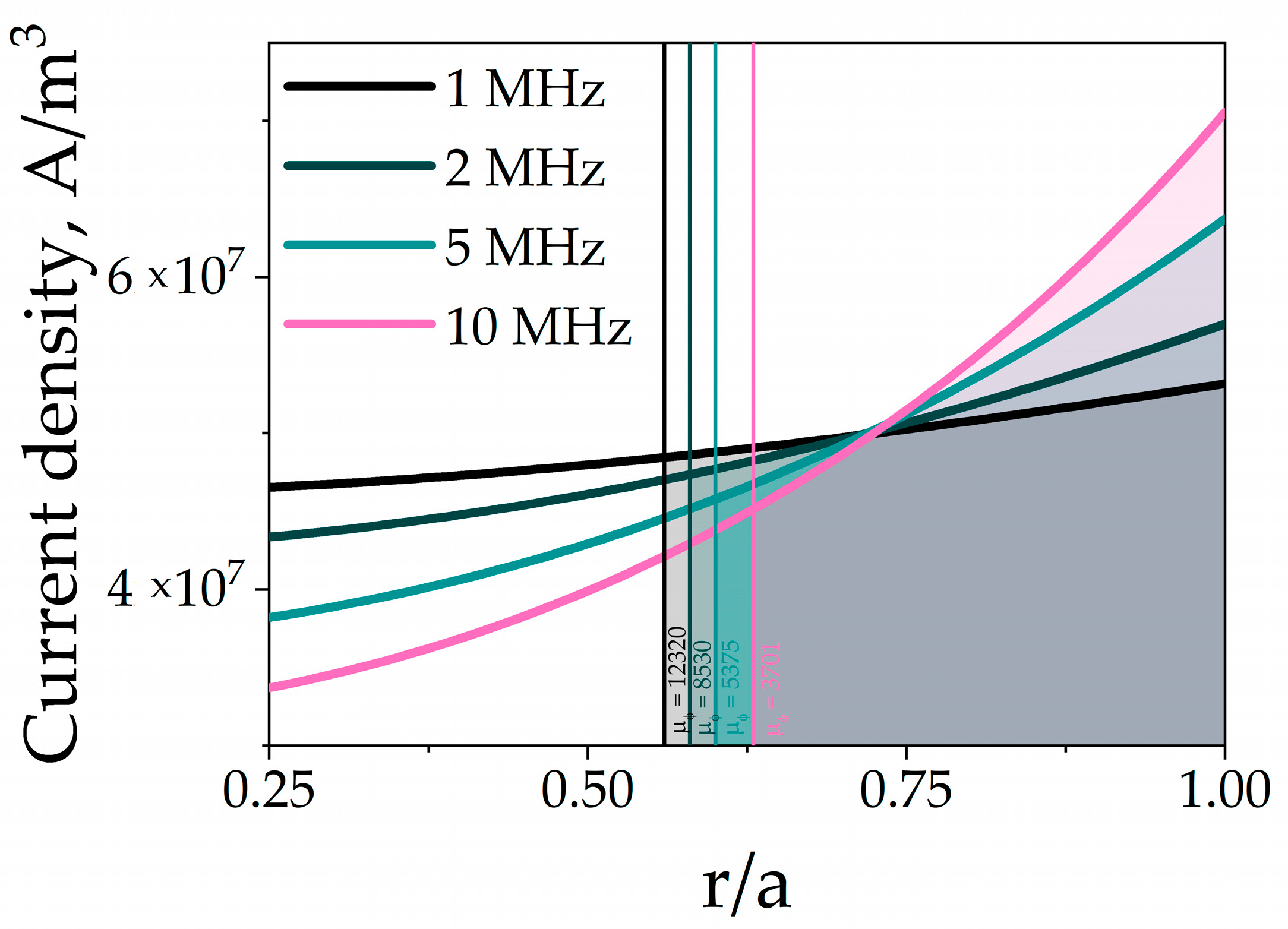
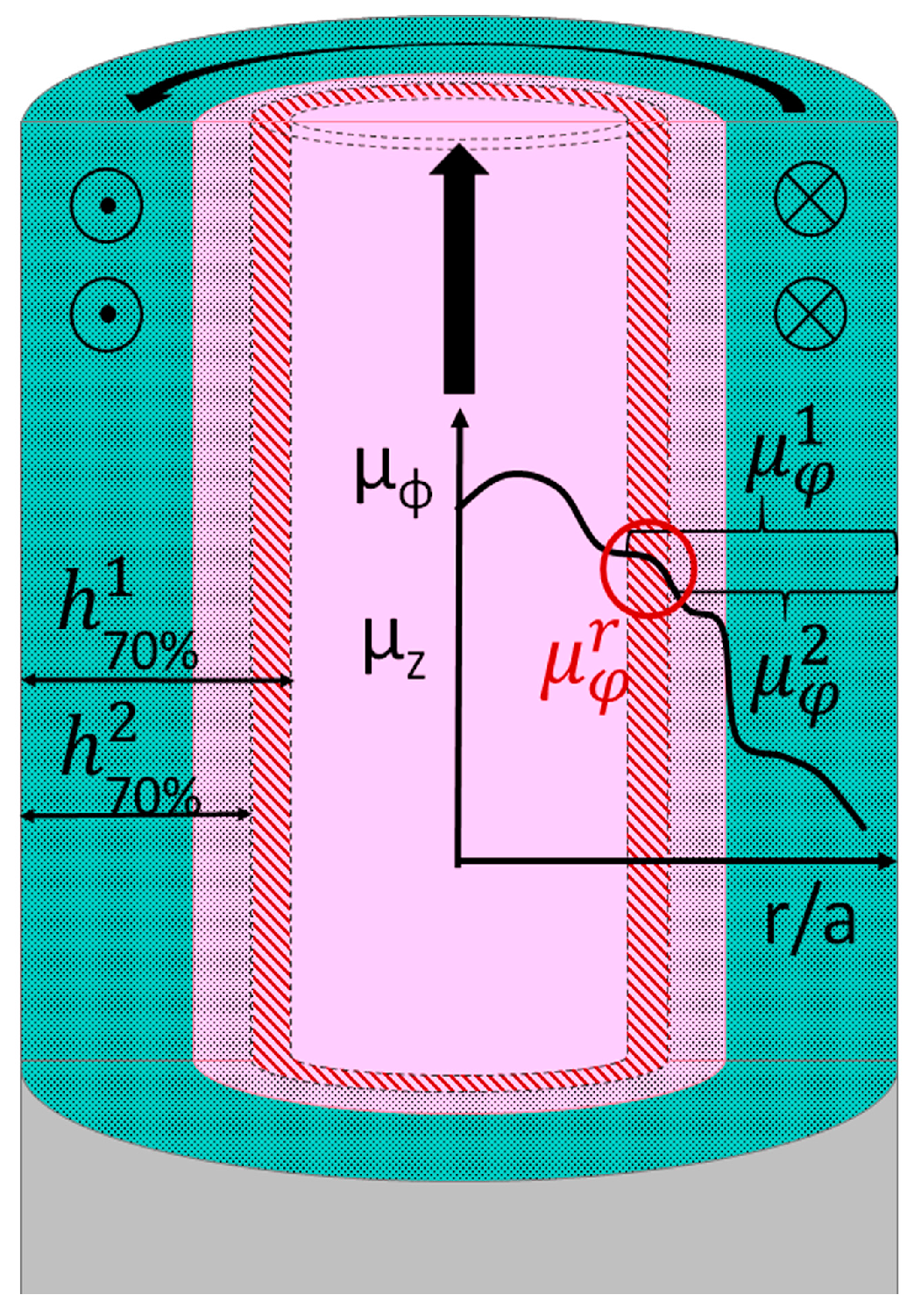
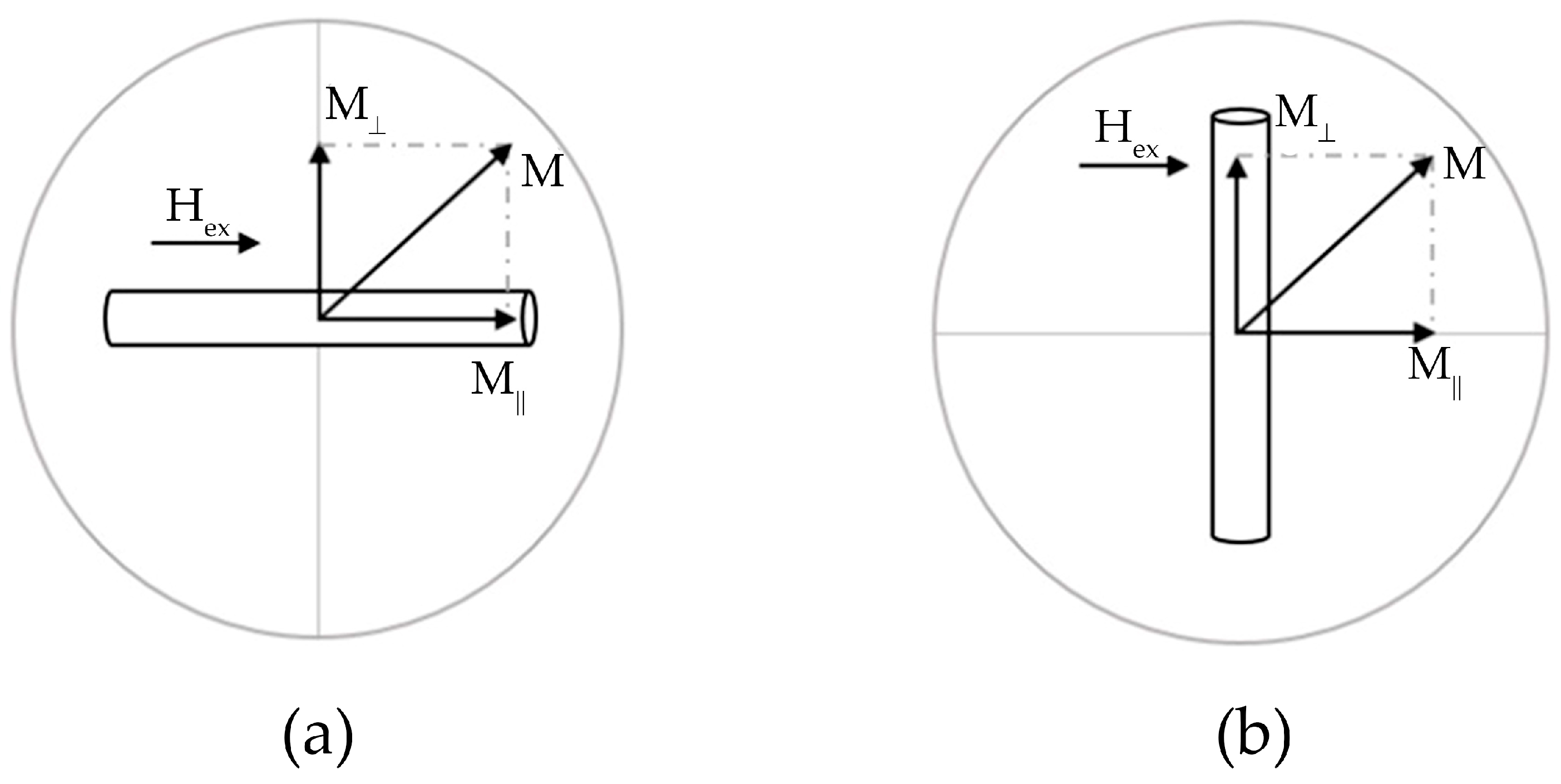


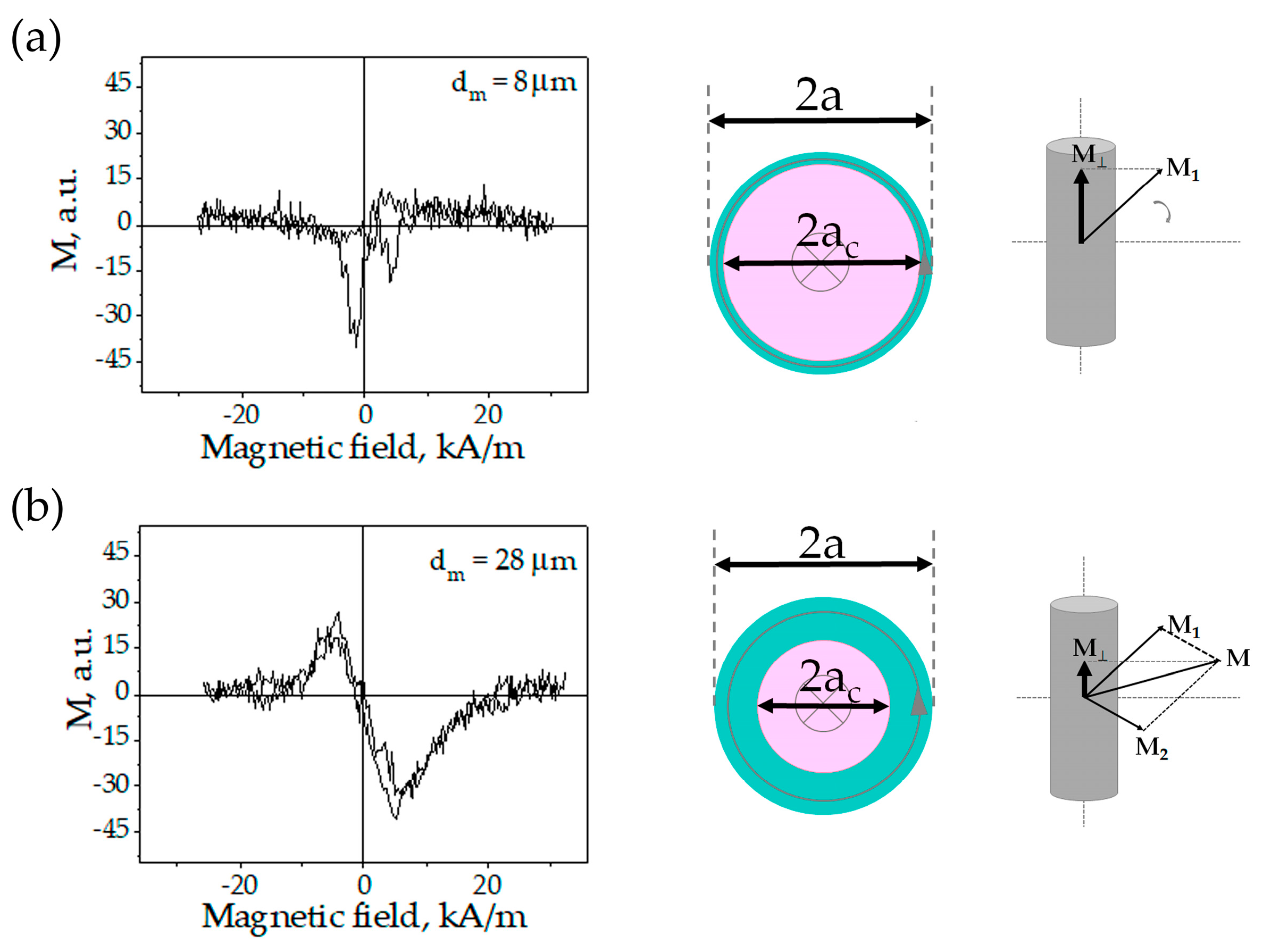

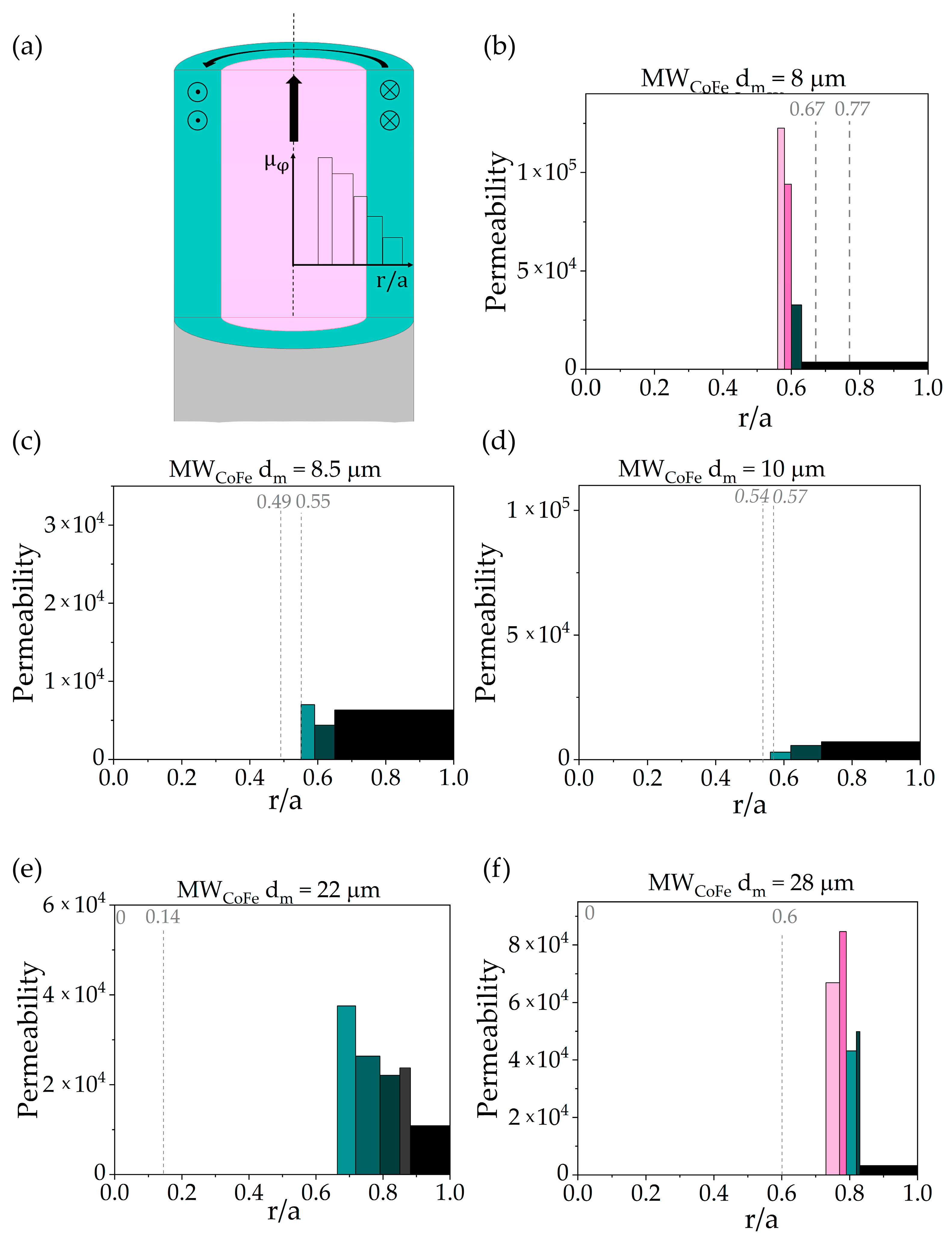
| Metallic Core Diameter, dm [μm] | Coercivity, HC [Oe] | Remanence to Saturation Ratio, MR/MS |
|---|---|---|
| 6.4 | 0.05 | 0.05 |
| 8 | 0.05 | 0.45 |
| 8.5 | 0.05 | 0.24 |
| 10 | 0.03 | 0.33 |
| 22 | 0.04 | 0.35 |
| 28 | 0.003 | 0.02 |
| Metallic Core Diameter, dm [μm] | Core Domain Radius, ac/a | Core Domain Radius, ac */a |
|---|---|---|
| 6.4 | ~0 | 0.22 |
| 8 | 0.77 | 0.67 |
| 8.5 | 0.55 | 0.49 |
| 10 | 0.54 | 0.57 |
| 22 | ~0 | 0.60 |
| 28 | ~0 | 0.14 |
| dm [μm] | Structure | Method Applicability |
|---|---|---|
| 6.4 | Circular without core, sharp permeability radial dependence | Not applicable |
| 8 | Circular | Applicable, core radius calculated—0.60 R |
| 8.5 | Axial | Not applicable |
| 10 | Axial | Not applicable |
| 22 | Circular | Applicable, measurements in the shell |
| 28 | Circular | Applicable, non-uniform permeability |
Publisher’s Note: MDPI stays neutral with regard to jurisdictional claims in published maps and institutional affiliations. |
© 2021 by the authors. Licensee MDPI, Basel, Switzerland. This article is an open access article distributed under the terms and conditions of the Creative Commons Attribution (CC BY) license (http://creativecommons.org/licenses/by/4.0/).
Share and Cite
Alekhina, I.; Kolesnikova, V.; Rodionov, V.; Andreev, N.; Panina, L.; Rodionova, V.; Perov, N. An Indirect Method of Micromagnetic Structure Estimation in Microwires. Nanomaterials 2021, 11, 274. https://doi.org/10.3390/nano11020274
Alekhina I, Kolesnikova V, Rodionov V, Andreev N, Panina L, Rodionova V, Perov N. An Indirect Method of Micromagnetic Structure Estimation in Microwires. Nanomaterials. 2021; 11(2):274. https://doi.org/10.3390/nano11020274
Chicago/Turabian StyleAlekhina, Iuliia, Valeria Kolesnikova, Vladimir Rodionov, Nikolai Andreev, Larissa Panina, Valeria Rodionova, and Nikolai Perov. 2021. "An Indirect Method of Micromagnetic Structure Estimation in Microwires" Nanomaterials 11, no. 2: 274. https://doi.org/10.3390/nano11020274
APA StyleAlekhina, I., Kolesnikova, V., Rodionov, V., Andreev, N., Panina, L., Rodionova, V., & Perov, N. (2021). An Indirect Method of Micromagnetic Structure Estimation in Microwires. Nanomaterials, 11(2), 274. https://doi.org/10.3390/nano11020274








